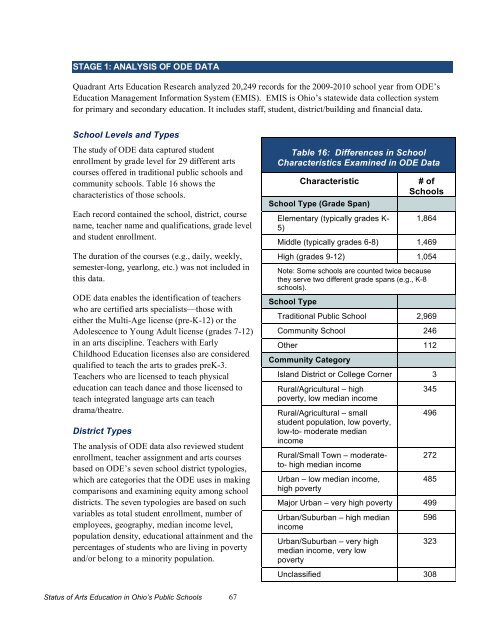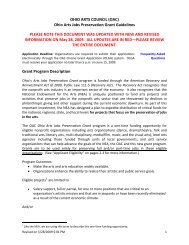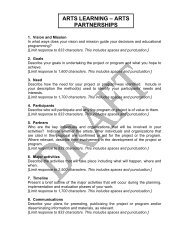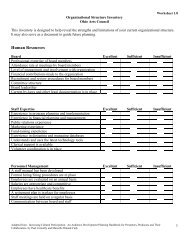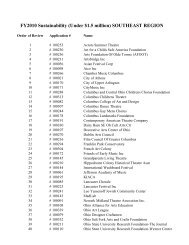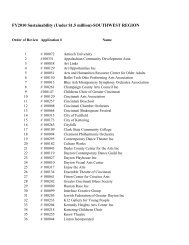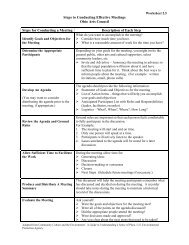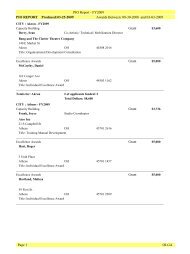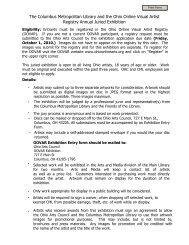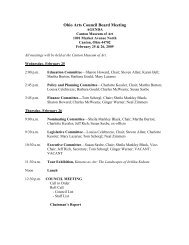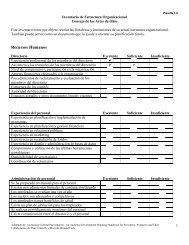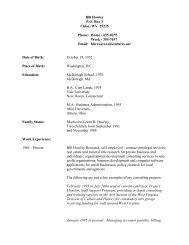The Status of Arts Education in Ohio's Public ... - Ohio Arts Council
The Status of Arts Education in Ohio's Public ... - Ohio Arts Council
The Status of Arts Education in Ohio's Public ... - Ohio Arts Council
Create successful ePaper yourself
Turn your PDF publications into a flip-book with our unique Google optimized e-Paper software.
STAGE 1: ANALYSIS OF ODE DATA<br />
Quadrant <strong>Arts</strong> <strong>Education</strong> Research analyzed 20,249 records for the 2009-2010 school year from ODE’s<br />
<strong>Education</strong> Management Information System (EMIS). EMIS is <strong>Ohio</strong>’s statewide data collection system<br />
for primary and secondary education. It <strong>in</strong>cludes staff, student, district/build<strong>in</strong>g and f<strong>in</strong>ancial data.<br />
School Levels and Types<br />
<strong>The</strong> study <strong>of</strong> ODE data captured student<br />
enrollment by grade level for 29 different arts<br />
courses <strong>of</strong>fered <strong>in</strong> traditional public schools and<br />
community schools. Table 16 shows the<br />
characteristics <strong>of</strong> those schools.<br />
Each record conta<strong>in</strong>ed the school, district, course<br />
name, teacher name and qualifications, grade level<br />
and student enrollment.<br />
<strong>The</strong> duration <strong>of</strong> the courses (e.g., daily, weekly,<br />
semester-long, yearlong, etc.) was not <strong>in</strong>cluded <strong>in</strong><br />
this data.<br />
ODE data enables the identification <strong>of</strong> teachers<br />
who are certified arts specialists—those with<br />
either the Multi-Age license (pre-K-12) or the<br />
Adolescence to Young Adult license (grades 7-12)<br />
<strong>in</strong> an arts discipl<strong>in</strong>e. Teachers with Early<br />
Childhood <strong>Education</strong> licenses also are considered<br />
qualified to teach the arts to grades preK-3.<br />
Teachers who are licensed to teach physical<br />
education can teach dance and those licensed to<br />
teach <strong>in</strong>tegrated language arts can teach<br />
drama/theatre.<br />
District Types<br />
<strong>The</strong> analysis <strong>of</strong> ODE data also reviewed student<br />
enrollment, teacher assignment and arts courses<br />
based on ODE’s seven school district typologies,<br />
which are categories that the ODE uses <strong>in</strong> mak<strong>in</strong>g<br />
comparisons and exam<strong>in</strong><strong>in</strong>g equity among school<br />
districts. <strong>The</strong> seven typologies are based on such<br />
variables as total student enrollment, number <strong>of</strong><br />
employees, geography, median <strong>in</strong>come level,<br />
population density, educational atta<strong>in</strong>ment and the<br />
percentages <strong>of</strong> students who are liv<strong>in</strong>g <strong>in</strong> poverty<br />
and/or belong to a m<strong>in</strong>ority population.<br />
Table 16: Differences <strong>in</strong> School<br />
Characteristics Exam<strong>in</strong>ed <strong>in</strong> ODE Data<br />
Characteristic<br />
School Type (Grade Span)<br />
Elementary (typically grades K-<br />
5)<br />
# <strong>of</strong><br />
Schools<br />
1,864<br />
Middle (typically grades 6-8) 1,469<br />
High (grades 9-12) 1,054<br />
Note: Some schools are counted twice because<br />
they serve two different grade spans (e.g., K-8<br />
schools).<br />
School Type<br />
Traditional <strong>Public</strong> School 2,969<br />
Community School 246<br />
Other 112<br />
Community Category<br />
Island District or College Corner 3<br />
Rural/Agricultural – high<br />
poverty, low median <strong>in</strong>come<br />
Rural/Agricultural – small<br />
student population, low poverty,<br />
low-to- moderate median<br />
<strong>in</strong>come<br />
Rural/Small Town – moderateto-<br />
high median <strong>in</strong>come<br />
Urban – low median <strong>in</strong>come,<br />
high poverty<br />
345<br />
496<br />
272<br />
485<br />
Major Urban – very high poverty 499<br />
Urban/Suburban – high median<br />
<strong>in</strong>come<br />
Urban/Suburban – very high<br />
median <strong>in</strong>come, very low<br />
poverty<br />
596<br />
323<br />
Unclassified 308<br />
<strong>Status</strong> <strong>of</strong> <strong>Arts</strong> <strong>Education</strong> <strong>in</strong> <strong>Ohio</strong>’s <strong>Public</strong> Schools 67


